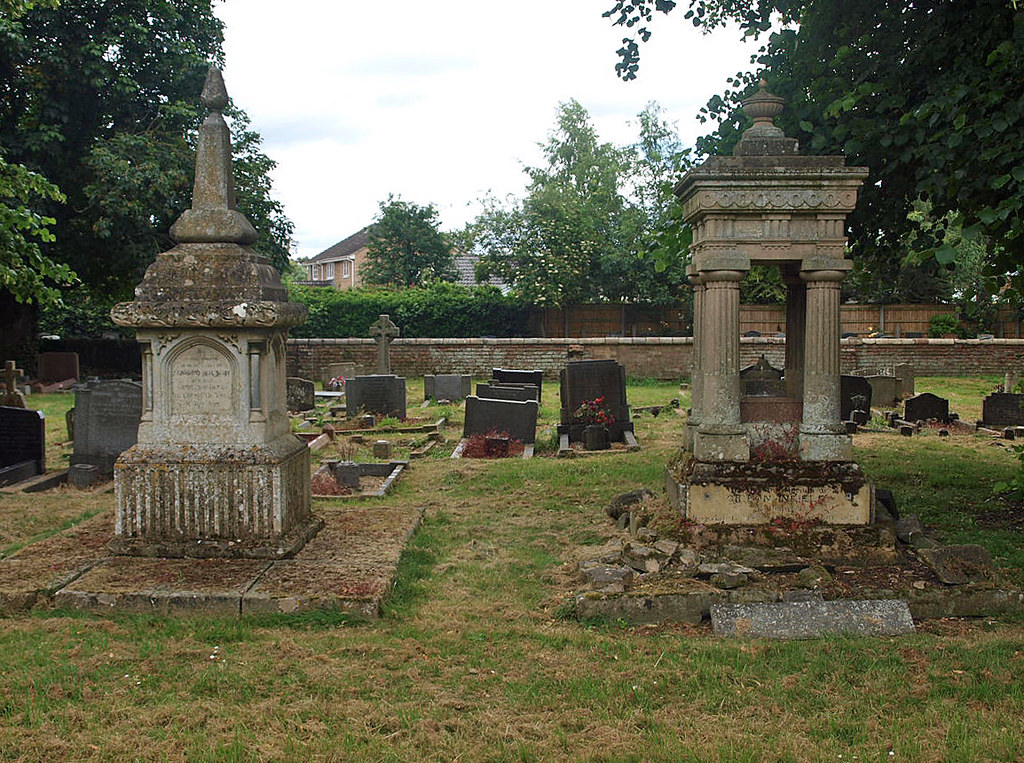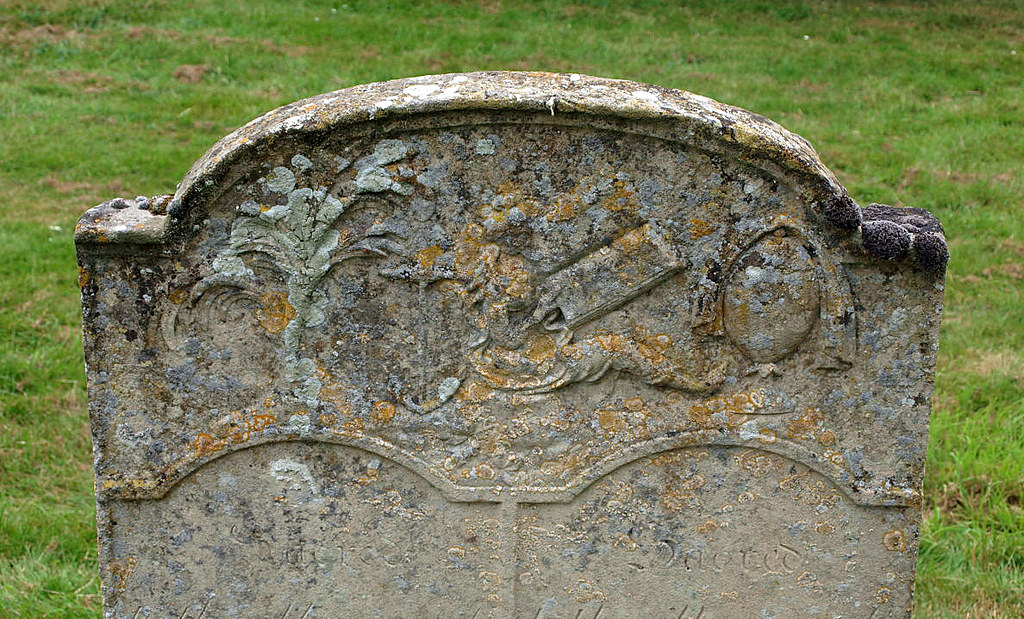Setting aside my outrage, it has to be said that this is a fascinating exterior surrounded by a fantastic collection of headstones and mausolea.
ST MARY. Of mid C13 date the chancel and the E end of the N aisle, see the hood-moulds on heads of the chancel windows, and, in the aisle, the clasping buttress at the E end and the window W of it which is of two lights and has plate tracery. Otherwise the church is in the main later C14, that is the W tower with its W window, E arch (no capitals) and recessed spire lit by two rows of dormer windows, the nave arcades on octagonal piers with two-centred arches in a double-wave moulding, the clerestory windows, and the chancel arch. The S porch was added in the early C15, and of the same period, though much renewed, is the nave roof with tiebeams on arched braces and tracery in the spandrels and above the beams. Carved demi-figures of angels on the tiebeams. The best piece of architecture at Doddington is the chancel, not so much on account of its C13 masonry, but because of the C15 windows ( but the E window is C19). The N and S windows are of three lights, with an embattled transom. The chancel arch starts with a straight piece on each side which dies into the arch. - ROOD SCREEN. One-light divisions, the arches of ogee-shape, tracery above them and a simple straight cresting. — RELIEF. Small wooden relief of Christ and the Samaritan Woman; Dutch? C18. - ROYAL ARMS, carved. - STAINED GLASS N aisle E window, early William Morris, given to the church in 1923. - GRAVE-STONES. A good group of carved C18 gravestones in the churchyard E of the S porch. - CROSS N of the churchyard. Base and lower part of shaft; C14.
DODDINGTON. It has known great days, for here was the palace of the bishops of Ely, and it was once the biggest parish in the county, with 40,000 acres and the wealthiest rectory in the kingdom. In those days one of its rectors was Christopher Tye, a famous musician in four reigns. He wrote masses when Henry the Eighth was king, composed Protestant hymns under Edward the Sixth, was music master under Mary Tudor, and was probably organist to Queen Elizabeth. He is said to have been rebuked by Elizabeth for playing out of tune, and to have told her majesty that her ears were out of tune. He has been called the Father of the Anthem, and he wrote a tune that is known to every English boy and girl, While Shepherds Watched their Flocks by Night. We may be sure that Christopher Tye would have been delighted with the story we heard from the rector. For years he had longed for a new organ, but his people were too small a flock to buy one, and Mr Ridge, the hopeful parson, inserted an appealing advertisement in the personal column of The Times with a result equal to all expectations, for the appeal touched the generous heart of somebody unknown who presented Doddington church with a brand new organ.
Doddington is great no more, but a quiet place set in the fens like an island in the sea, the fens being now all green with patchwork fields. It has a black timber windmill a century old, and its church, just off the busy road, has a few things to show us of medieval days. The tower and spire and the lofty arcades are five or six centuries old; the porch, with its pinnacles and battlements, is 15th century, the chancel arch is 13th, and in it is a 15th century oak screen. The modern roof rests on corbel heads of men and women and is adorned with angels. One of the windows is by William Morris, a Calvary, with the Madonna and three saints at the foot of the Cross; it was brought here from London in memory of a rector who had come from the East End for his health’s sake, and it was dedicated by the hero * of Kut, Sir Charles Townshend. It was his last public act. Another window is to a churchwarden for 66 years, and there is a tablet to Algernon Peyton who was rector last century for 57 years.
* Historian Christopher Catherwood has called the siege "the worst defeat of the Allies in World War I" so quite why he's the hero of Kut I don't know.
Doddington is great no more, but a quiet place set in the fens like an island in the sea, the fens being now all green with patchwork fields. It has a black timber windmill a century old, and its church, just off the busy road, has a few things to show us of medieval days. The tower and spire and the lofty arcades are five or six centuries old; the porch, with its pinnacles and battlements, is 15th century, the chancel arch is 13th, and in it is a 15th century oak screen. The modern roof rests on corbel heads of men and women and is adorned with angels. One of the windows is by William Morris, a Calvary, with the Madonna and three saints at the foot of the Cross; it was brought here from London in memory of a rector who had come from the East End for his health’s sake, and it was dedicated by the hero * of Kut, Sir Charles Townshend. It was his last public act. Another window is to a churchwarden for 66 years, and there is a tablet to Algernon Peyton who was rector last century for 57 years.
* Historian Christopher Catherwood has called the siege "the worst defeat of the Allies in World War I" so quite why he's the hero of Kut I don't know.



No comments:
Post a Comment